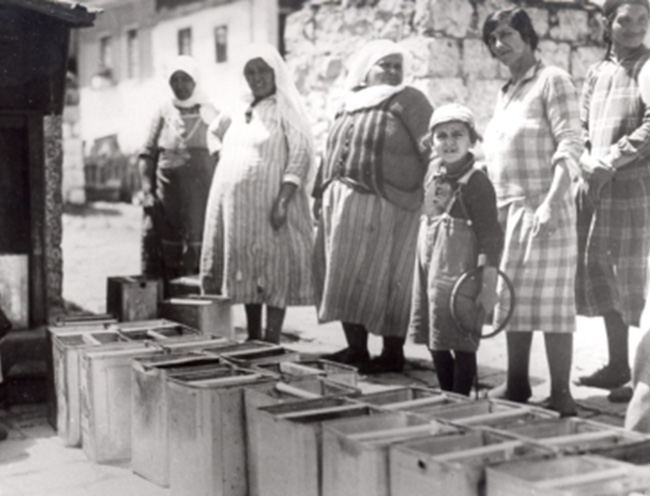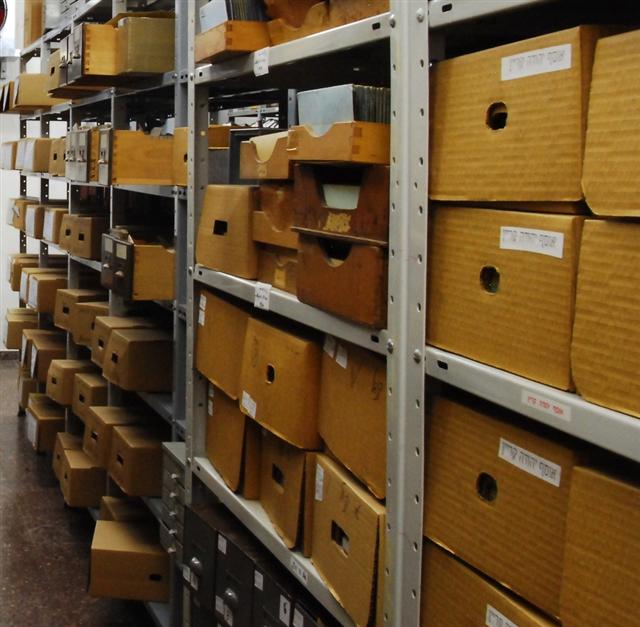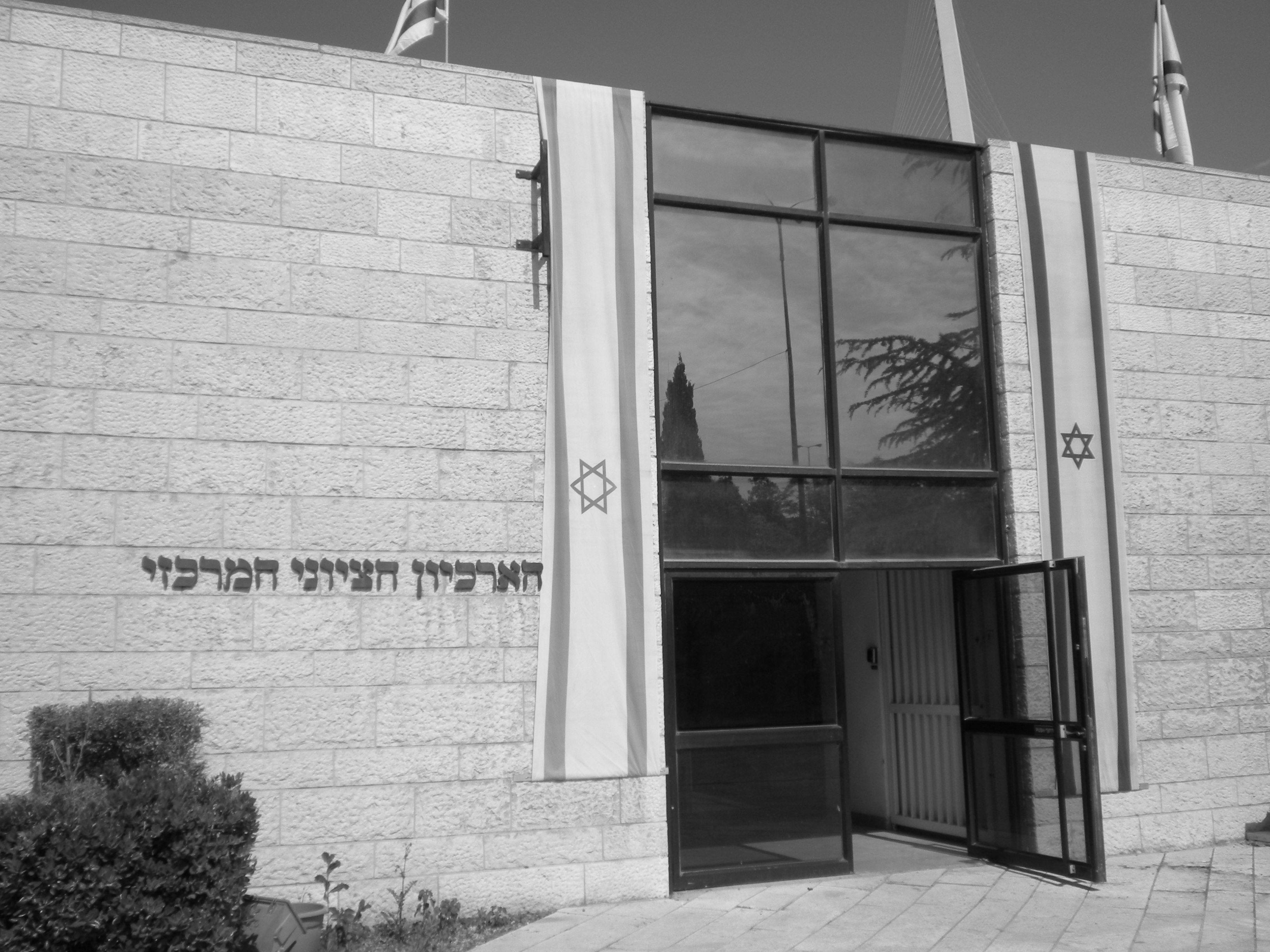Written by Liora R. Halperin
The Central Zionist Archive (hereafter CZA) in Jerusalem is the main archival resource for scholars researching the history of the Zionist movement, both within Palestine/Israel and internationally, and the history of the Yishuv (the Jewish community in Palestine) during the British Mandate and late Ottoman periods. Any scholar researching a topic that relates, either directly or indirectly, to the Jewish community in pre-state Palestine or the international institutions of the Zionist movement (e.g. the World Zionist Organization, the United Israel Appeal, or the Jewish Agency) will find the CZA to be an important archive.

History
The Central Zionist Archive was founded in Berlin in 1919 as the archive of the Zionist Movement; its goal was to collect the documentation of the branches of the Zionist movement located around the world, as well as the personal archives of key Zionist leaders. The first director of the archive, Georg Herlitz, began ordering the archive according to the organizational structure of the various offices that produced the documents in the collection. In the wake of the Nazi rise to power in 1933, the archive was moved to Israel and opened to the public in 1934. At this point, the collection’s focus expanded well beyond the history and bureaucratic activities of the global Zionist movement to include also the history of the Yishuv and Jewish settlement in Palestine. Alex Bein, the long-serving director of the archive, worked to realize the expansion of the collection as well as the transfer of Theodor Herzl’s archive to Palestine in 1937. Bein also gathered the personal archives of several other early Zionist figures. After being located for decades in the basement of the Zionist institutional offices on King George Street, the archive was moved into its current location in 1987.
Collection
Next to the Israel State Archives, the Central Zionist Archive is the largest archive in Israel. The Central Zionist Archive has, according to one estimate, about 80 million documents—a quantity which one writer described in 2007 as “ten kilometers of Zionism” (Anat Banin, “The Treasure Vault of the Jewish People” The Jewish Magazine, Hanukkah 2007). The CZA contains the archives of, among other bodies, the committees, subcommittees, and offices of the World Zionist Organization, as well as the Jewish Agency, the Jewish National Fund, the United Israel Appeal (Keren Ha-Yesod), and the Jewish National Council (Va‘ad ha-Le’umi). It also holds the records of other Zionist organizations and institutions in countries around the world and in Palestine/Israel, the records of Zionist Congresses, and over 1500 personal archives as well as extensive collections of periodicals, images, and maps. Most of these documents were produced in bureaucratic offices, mainly in the twentieth century, with a smaller number of documents from the late nineteenth century and a growing collection oftwenty-first-century collections from currently active Zionist organizations around the world. Approximately one-third of these documents are from the period of the Holocaust, making the CZA an important source for materials pertaining to Zionist activity during the Second World War. It also has a large collection of newspapers, maps, and half a million photographs and negatives. The CZA also has a unit for family research, and charges a fee of 100 shekels for individuals and 150 for institutions to look into immigration records, primarily for those who entered the country between 1919 and 1974. It also possesses a large book collection.

The contents of the CZA’s collections and sub-collections are listed on the archive’s website, which was updated relatively recently and is user-friendly. Researchers are advised to use the online lists and come on the first day of research with an initial list of materials they wish to order.
It should be noted that the documents held in the Central Zionist archive, with a few exceptions, were those either created or received by the Zionist movement, or, more specifically, associates of the Zionist Organization, as opposed to affiliates of the Labor Zionist or Revisionist movements. A wide range of organizations associated with the Zionist labor movement including MAPAI, Ha-Shomer Ha-Tza‘ir, the Kibbutz HaMe’uhad, the Histadrut, as well as the archives of the Revisionist Movement and of local municipalities, are held in other organizational or municipal archives located around Israel. Moreover, while the Central Zionist Archive is a central archive for the history of pre-state Zionism and the proto-state institutions of the Yishuv, the archives of the British mandatory government in Palestine are not held at the Central Zionist Archive, but rather at the Israel State Archives, where they were transferred after the creation of the state. A basic understanding of the structure and political diversity of the Zionist movement is essential to predict whether a given document or collection is likely to be held at the CZA or a separate archive elsewhere in Israel.
While the CZA holds materials from the Jewish community of Palestine up to 1948, it also contains and continues to collect the documents of certain international Zionist organizations outside the direct purview of the Israeli state. Given the worldwide nature of the Zionist movement, the archive contains materials from all major sites of Zionist movement activity including Europe, the United States, Canada, Australia, South Africa, and South America. It contains materials from Palestine and from other Middle Eastern locations where the Zionist movement was active. Given the global reach and extent of these materials, the archive has important information on other topics, for example, global Jewish communities, resistance to Zionism, major events in Jewish history, the Arab population of Palestine, etc. However, visitors should plan their research mindful of the explicitly political and ideological logic—chronicling the history of the Zionist movement—by which the collection was assembled. The bulk of the collection is in Hebrew, but Zionist records from the late nineteenth and early twentieth century are more likely to be in German, and the records and correspondence of Zionist organizations around the world will likely be in the state languages of their respective countries.
Research Experience
The collections are organized, by and large, with reference to a document’s institutional place of production. In other words, the structure of the collections follows the structure of the institutions from which they came. Each top-level archival designation refers to a different institution. Some of the largest are the Va’ad Ha-Le’umi (Jewish National Council, archive code J), the Jewish Agency (archive code S), the Jewish National Fund (archive code KKL), Keren Ha-Yesod (United Israel Appeal, archive code KH), Zionist Organization Offices in various cities (archive code Z), and the Zionist Commission (archive code L). The number following the initial letter usually refers to a particular office or committee within the organization (e.g. J2 or S25). The number following the slash is the folder number. Personal archives have designations starting with the letter A. Although it is possible to find files by keyword, it is helpful to pay attention to the top-level letter and number for any given source in order to understand accurately its bureaucratic origin.
There are two basic ways to access catalogs. The computerized catalog is the main way to search for files, and one can search by keyword, as well as by year and other parameters. The operation of the computerized catalog is not immediately intuitive, and researchers should plan to ask for help from the reading room staff.
The second way to search the collections are through the bound volumes for each archival unit, which are organized by letter and are located to the left of the main desk in the reading room. Some of these volumes are missing, but if the one you need is on the shelf, the low-tech browsing method can be a useful way to understand the overall organization of each archival unit. Researchers normally request material through the computer system. In the event that the computer system is inoperable, researchers may continue to make requests using the paper slips. In my experience, computer outages are not uncommon, but this issue may have been resolved.
Thanks to support from the Judaica Division of the Harvard University library, the Holocaust Museum in Washington, DC, and the Claims Convention, the organization that distributes and allocates the funds of German Holocaust reparation payments to Israel, the CZA is digitizing its collections and researchers should expect that a good proportion of their documents will be viewed not on paper but on the computer terminals located in the reading room. Digitized documents are not always high quality, and, except for maps and other full-color documents, scans are in black and white. It is therefore occasionally difficult to read documents. Moreover, the functions for zooming and moving between pages are sometimes frustrating and the overall experience of dealing with scanned documents may be more difficult and less efficient than handling paper documents. In cases where the digital copies of documents are illegible, one can request paper files, but there is not an organized or streamlined procedure for such requests.
There are five pull times over the course of the day: 9:00, 10:00, 11:30, 13:00, 14:00. Five items (a book, a folder, etc.) may be requested at each of these times, for a maximum of twenty-five items over the course of a day. This means that researchers who intend to look at a large number of files will need several days before all their files can be brought. However, once a set of files is requested, it can be stored on a hold shelf indefinitely as long as you are still working with it. Files that are scanned can be accessed at any time, so it makes sense to start the day focusing on what files need to be ordered, and then work with scanned files while waiting for the paper files to arrive.

The reading room staff are helpful. It is important for researchers to enter with the mindset that they need to continue asking questions if they find the initial responses insufficient. The reading room staff speaks some English but researchers who do not know Hebrew often find this to be a real impediment to their research. It is also not a bad idea to ask other archive users for help if the archive staff is away from the desk. The reading room staff, though they can answer questions about the procedures of ordering files or making copies, are not the ones to answer research questions or questions about the organization of the archive. Instead, researchers should turn to Batia Leshem, Head of Institutional Archives, or Rochelle Rubenstein, Deputy Director of Archival Matters, for those sorts of conversations. Their offices, as well as the offices of other archivists, are located one level below the reading room. Ask at the security desk in the lobby for specific directions to their offices.
The reading room is sufficiently comfortable. It tends to have enough room for the number of researchers who are normally working there without feeling either empty or overcrowded. It is air-conditioned. Researchers are asked to deposit their belongings in a locker outside and not bring in food or water. There is not an extremely rigorous search process in this regard but researchers should be prepared to abide by these regulations.
There are a wide range of reference volumes in the reading room itself, including dictionaries between Hebrew and a variety of other languages, a range of different historical and biographical encyclopedias, and a range of books about the history of the Zionist movement.
Access
The archive is open between 8:00 and 15:30, Sunday through Thursday. Users should be aware that the archive is closed for all major Jewish and Israeli national holidays, including often the whole day or half day of the eve of a holiday. Given the seasonal arrangement of holidays, this means that researchers planning travel in September-October and April-June in particular should consult a calendar and make sure that they are not planning research during a period of multiple holiday closures. In addition, the archive closes for a break in mid-August (call ahead before you come since closure information is not always posted on the website).
Access to the archive is granted after the submission of a short application. Researchers should make an application appointment and come to the archive with their Israeli identification number or foreign passport number.. Researchers have gained access without a formal letter of introduction, but it is not a bad idea to have one, especially for doctoral students. Once one is in the system, one does not have to fill out subsequent paperwork for future visits, even if one is working on an entirely different project, but it is helpful to consult with the archive staff to orient oneself around each new topic.
The archive is wheelchair accessible.
Reproductions
Researchers are asked to pay (as of 2012) 40 agorot per page for photographs taken on a personal digital camera. This is charged through self-reporting. It is useful to be able to customize one’s own images, zoom or crop as desired. Also, this is the cheapest form of reproduction available.
If one wishes to have photocopies made of paper files, they must be marked on a special ordering sheet and cost 1 shekel per page. They are normally ready within a week.
Documents that have been scanned cost 1.50 shekel per page if printed and 2 shekalim per page if emailed and they must be ordered and take some time to arrive (this is another reason why it is often a boon to chance upon files that have not yet been scanned that you can photograph with your own camera).
Transportation and Food
The CZA is located directly across from the Jerusalem Central Bus Station and next door to the Binyane Ha-Umah International Convention Center. The CZA is extremely well serviced by public transit. The light rail makes a stop outside the Central Bus Station and any bus, whether in the city or inter-city, that serves the Central Bus Station will do (from the bus station cross Jaffa Road and Zalman Shazar Ave. Follow Josef Herlitz Rd off of Zalmar Shazar Ave to the right of the Convention Center to get there.) In addition, it is useful to know that it is only about a twenty-minute walk between the Central Zionist Archive and the National Library at Hebrew University’s Giv’at Ram campus. This proximity between institutions is useful to maximize one’s working hours, as the CZA closes at 15:30, while the National Library remains open until 19:45.
There are a couple food options near the Central Zionist Archive. A small food cart on Zalman Shazar Ave. near the bus stops sells snacks and basic prepared sandwiches of poor quality. The other option is crossing over to the Central Bus Station, which has a food court with decent fast-food style options. The bus station is also a reasonably pleasant place to get coffee or a pastry and it has free wi-fi and various shops. If you want to make the most of the research hours between 8:00 and 15:30, however, the best idea is to pack a lunch.
Miscellaneous:
The archive occasionally hosts lectures and symposia related to topics in the history of the Zionist movement. Sometimes it also organizes small exhibits in its lobby space.
Future Plans and Rumors
The archive plans to continue digitizing files.
Contact information
Website: www.zionistarchives.org.il
Address: 4 Zalman Shazar Avenue, Jerusalem
Director: Yigal Sitry
Phone number: 972-2-620-4800
Fax: 972-2-620-4837
Main contact email: cza@wzo.org.il
Other emails and phone numbers:
| Academic Director | Dr. Motti Friedman | 02-620-4803 | motif@jazo.org.il |
| Administrative Director | Gili Simha | 02-6204800 | gilis@wzo.org.il |
| Deputy director for archival matters | Rochelle Rubinstein | 02-6204816 | rocheller@wzo.org.il |
Heads of Departments:
| Institutional archives | Batia Leshem | 02-6204818 | batial@wzo.org.il |
| Private archives | Simone Schliachter | 02-6204817 | simones@wzo.org.il |
| Photograph Collections | Anat Banin | 02-6204825 | anatb@wzo.org.il |
| Graphic Collections and Maps | Nechama Kanner | 02-6204810 | nechamaka@wzo.org.il |
Resources and Links:
3 December 2013
Liora R. Halperin is assistant professor of History and Jewish Studies at the University of Colorado, Boulder. Her research focuses on Jewish cultural history, Jewish-Palestinian relations in Palestine and Israel, language ideology and policy, and the politics surrounding nation formation in Palestine in the years leading up to the creation of the State of Israel in 1948. Her first book, tentatively titled Babel in Zion: Hebrew and the Politics of Language in Palestine, will be published by Yale University Press in 2014.
Cite this: Liora R. Halperin, “Central Zionist Archive,” HAZINE, https://hazine.info/2013/12/03/central-zionist-archive/, 3 Dec 2013


see our post here about using NLI’s Hebrew manuscript database as a portal of online research .
http://imhm.blogspot.co.il/2012_08_01_archive.html